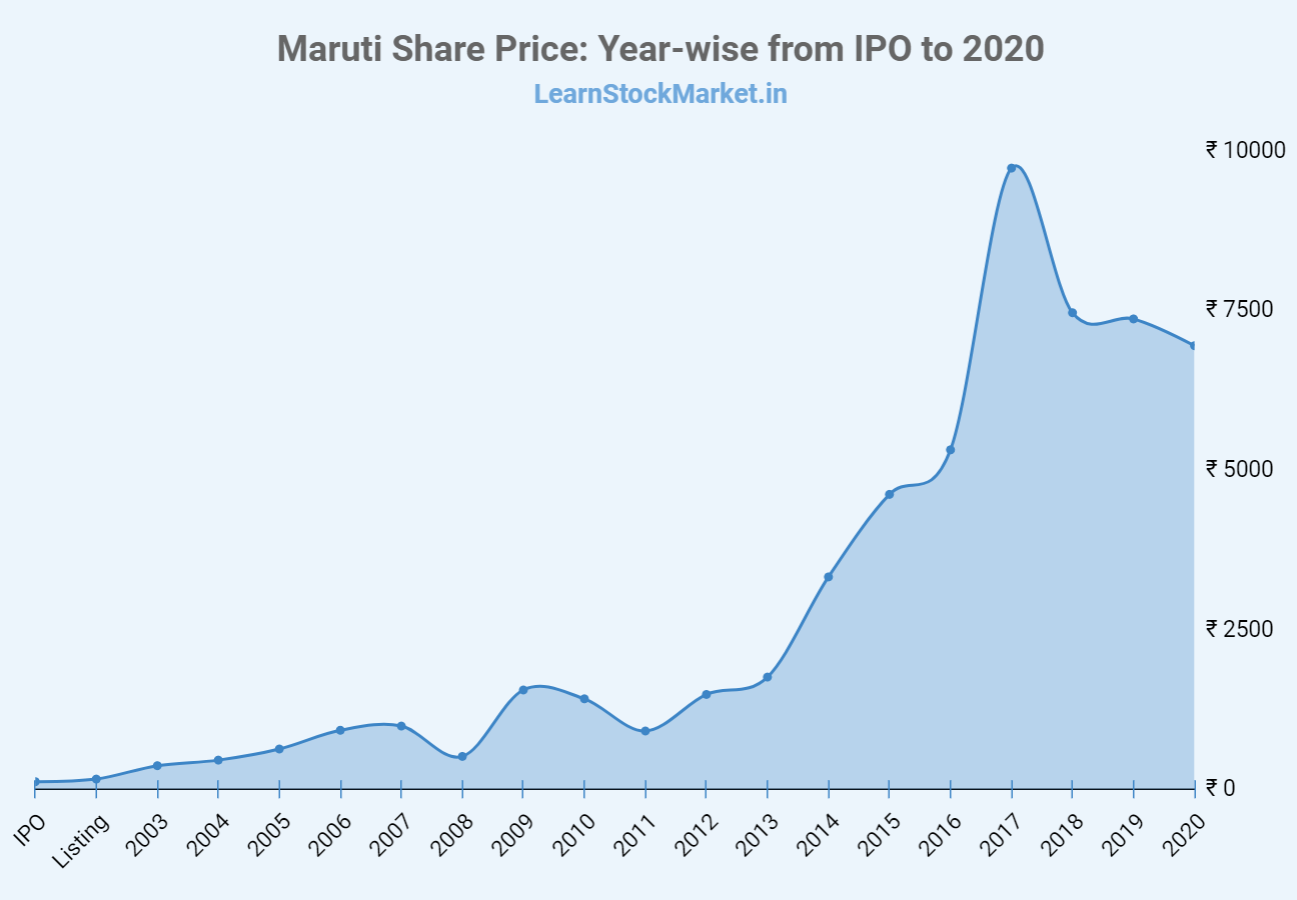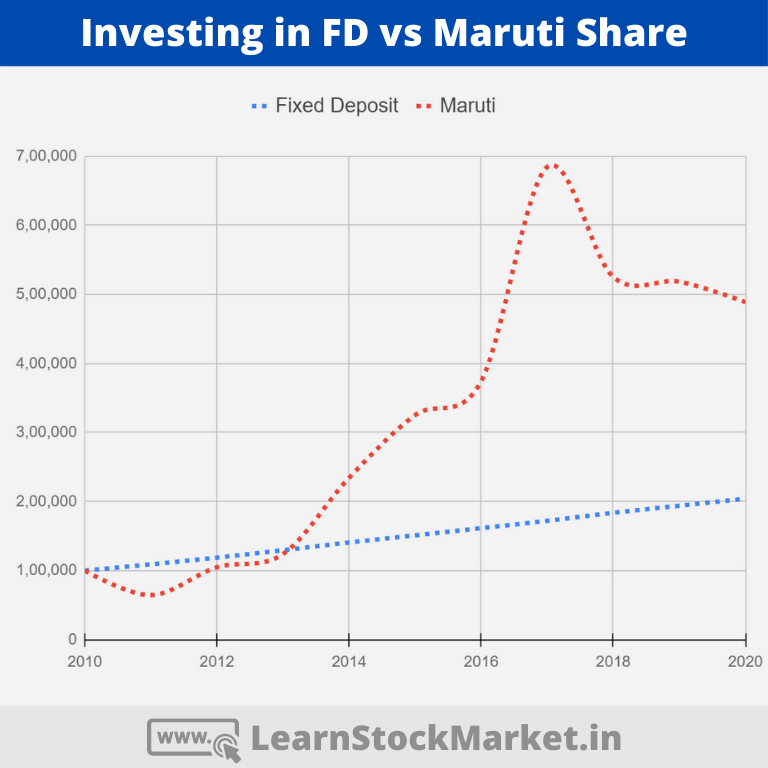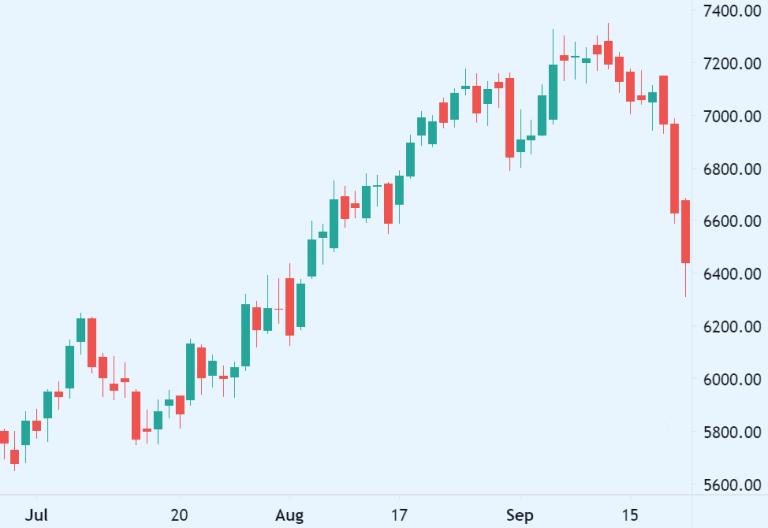Maruti Suzuki Limited is the Number 1 automobile company in India, commanding a market share of more than 50% in the 4-wheeler segment.
One in every two cars you see on the road today is a Maruti Suzuki. This domination has made Maruti the 14th most-valued company in the Indian stock market.
In this article, we cover the journey of the iconic company from the time it was first listed in 2003 to 2020.
Maruti Share Price History

The Maruti journey at the stock market started in 2003 when the Government of India decided to divest 25% of its stake in Maruti Udyog Limited (old name).
The IPO price was set at ₹ 125 per share. The IPO was over-subscribed 13 times. Those who were lucky to get allotment, were rewarded on the first day itself.
On July 9th 2003, Maruti was first listed on the stock exchanges in India. The share opened at ₹ 165, hit a high of ₹ 170, fell to ₹ 155 and finally ended its day at ₹ 164 per share. A listing gain of 31%.
Great interest in the IPO and fantastic listing. But it did not stop there.
By the end of the year 2003, within 6 months of its listing – the share price of Maruti rose to ₹ 375 per share. Even those who missed the IPO and bought at ₹ 165 after listing – were rewarded with 127% absolute returns in just 6 months.
Since then, the journey hasn’t been smooth, but Maruti has rewarded its shareholders with consistent dividends and excellent returns from growth in value of the share – this has been possible due to Maruti’s domination of the automobile sector and steady growth in car sales across the country.
| Maruti | Share Price | Rise / Fall |
| IPO | ₹ 125 | |
| Listing | ₹ 165 | 32% |
| 2003 | ₹ 375 | 127% |
| 2004 | ₹ 462 | 23% |
| 2005 | ₹ 636 | 38% |
| 2006 | ₹ 929 | 46% |
| 2007 | ₹ 995 | 7% |
| 2008 | ₹ 520 | -48% |
| 2009 | ₹ 1560 | 200% |
| 2010 | ₹ 1422 | -9% |
| 2011 | ₹ 918 | -35% |
| 2012 | ₹ 1490 | 62% |
| 2013 | ₹ 1762 | 18% |
| 2014 | ₹ 3330 | 89% |
| 2015 | ₹ 4622 | 39% |
| 2016 | ₹ 5320 | 15% |
| 2017 | ₹ 9730 | 83% |
| 2018 | ₹ 7466 | -23% |
| 2019 | ₹ 7369 | -1% |
| 2020 | ₹ 6950 | -6% |

Those are the year-end prices of the Maruti share. The chart looks great, doesn’t it?
A ₹ 125 share is now valued at nearly ₹ 7000. Sounds fantastic, but in reality it was far from easy.
Picking quality stocks is easy, even giving the right allocation isn’t difficult. But staying invested in a company for a long period of time, is probably the most difficult part of investing.
Observe the chart (or table) above carefully and think from the point-of-view of an investor, who invested in the company in 2003 or 2004.
Sure, the stock price went up. But to enjoy the massive gains the company has given between 2011 – 2017, an investor had to see through two periods of massive downfall.
From the end of 2007 to the end of 2008, Maruti crashed by nearly 50%. Nearly all the gains made between 2004 to 2007 was lost in a single year – the great market crash of 2008.
Those who survived 2008 were rewarded in 2009 by 200% gains – but were tested once again in 2010 and 2011 which were extremely painful as the stock crashed by 45% during that period.
If you lost hope in 2011 and sold the shares of Maruti, you would’ve lost all the gains for 6 consecutive years between 2012 – 2017.
Maruti is testing its long-term investors yet again – as the stock hasn’t performed since 2018. From a high of ₹ 10,000 per share on December 20 2017, the Maruti share price crashed to ₹ 4001 on April 3rd 2020.
On that one day in April 2020, all the gains in stock price between 2015 – 2020 were lost.
Who said long term investing is easy? It’s painful. It’s difficult. And because it is difficult, it can be extremely rewarding too. There is no gain, without lots of pain in the stock market.
Even though the stock has recovered from its Covid-lows, Maruti is still 30% down from its 2017 highs.
Car sales are down, the economy is struggling due to Coronavirus. People are losing jobs.
During such times, when there is negativity all around. Very few people would be interested in buying Maruti shares. No one knows how many years the share could under-perform.
There is also a lot of uncertainty around electric cars and whether Maruti can make the transition. Companies that have been slow to transition have been wiped out – Nokia and Kodak are examples of this.
If the company does well. If the economy grows and Indians go out to buy cars in big numbers once again – Maruti could become a ‘multibagger’ even from here.
Here is a stat that could get you interested.
- India – 22 out of 1000 people own cars.
- China – 164 out of 1000 people own cars. Nearly 8 times more than India.
- Canada – 662 people out of 1000 have cars. Far more than India.
- UK – 850 out of 1000.
- United States – 980 out of 1000. Almost every adult has a car.
Source for the above information: Times of India
India has a long way to go. Even if 50 out of 1000 people own cars in India – most of those cars could well be a Maruti.
After all, India trusts the brand, it’s after sale service and also it’s service centers and dealers are spread across the length and breath of the country.
At the same time – there could be a shift with people preferring renting a Ola or Uber, instead of buying a car. There could be a competitor who takes away market share (Hyundai for example).
These are the challenges that every long term investor faces. The future is always uncertain, this makes returns from the stock market uncertain too.
Let’s move on to the next section.
Maruti Share Returns: Compounded and Absolute
How much returns has Maruti Suzuki given if you bought the share 2 years ago? Or 3, 4 or 5 years ago.
What if you were holding Maruti shares from the time of its IPO? What if you bought on the listing day at ₹ 165 per share and managed to hold it through its ups and downs.
Check out the table below.
| Time Period | CAGR | Absolute |
| 2 years | -3.52 | 0.93 times |
| 3 years | -10.61% | 0.71 times |
| 4 years | 6.91% | 1.31 times |
| 5 years | 8.50% | 1.50 times |
| 10 years | 17.19% | 4.89 times |
| 15 years | 17.28% | 10.9 times |
| Since Listing | 24.61% | 42.1 times |
| Since IPO | 26.66% | 55.6 times |
Maruti has compounded at an excellent rate of 26.66% if you were holding the shares from IPO. It has given nearly 25% returns if you bought on the day it was listed on the stock exchange.
The last 3 years have been poor, but the 10 and 15 year returns are still excellent. And it does not include dividends which the company has been giving to its shareholders.
1 lakh invested in Maruti Suzuki
Suppose you invested 1 lakh rupees in Maruti, how much would it be over different time periods?
The answer is in the table below:
| Time Period | 1 Lakh Invested |
| 2 years | ₹ 93,089 |
| 3 years | ₹ 71,429 |
| 4 years | ₹ 1,30,639 |
| 5 years | ₹ 1,50,368 |
| 10 years | ₹ 4,88,748 |
| 15 years | ₹ 10,92,767 |
| Since Listing | ₹ 42,12,121 |
| Since IPO | ₹ 55,60,000 |
Maruti Share vs FD Returns
What if you opened a fixed deposit of 1 lakh and made another investment of 1 lakh in Maruti Suzuki Limited.
The results are below. Again, the returns from Maruti does not include dividends.
| Fixed Deposit | Maruti | |
| 2010 | 1,00,000 | 1,00,000 |
| 2011 | 1,09,130 | 64,557 |
| 2012 | 1,18,821 | 1,04,782 |
| 2013 | 1,29,515 | 1,23,910 |
| 2014 | 1,40,692 | 2,34,177 |
| 2015 | 1,51,075 | 3,25,035 |
| 2016 | 1,61,469 | 3,74,121 |
| 2017 | 1,72,093 | 6,84,248 |
| 2018 | 1,83,710 | 5,25,035 |
| 2019 | 1,93,997 | 5,18,214 |
| 2020 | 2,04,027 | 4,88,748 |
| Returns | 7.39% | 17.19% |

Some points to be noted:
- Notice the two lines in the graph above. One moves in a straight predictable line, the other is unpredictable.
- If you invested in 2010 in Maruti, for the first 3 years your returns would’ve been lower than FD.
- In fact, the first two years you would’ve been in loss. Many would sell at this point.
- It’s only after the 3rd year that the investment began to grow exponentially.
- At one point in 2017, the absolute returns from Maruti shares was 8 times more than FD.
- Then the stock crashed, but over a period of 10 years, an investment in Maruti would’ve given you significantly higher returns than fixed deposit.
- Why would anyone invest in FD when stocks can give such excellent returns? The answer is risk and volatility.
- Returns from FD are guaranteed. A middle-class person who receives a salary every month, sacrifices his lifestyle to save some money. Imagine the pain he would feel when the value of his investment goes down.
- This is exactly why people prefer the safety and comfort that a fixed deposit provides.
- Over a 10-year period, fixed deposits would’ve given you 7.39% returns (Data calculated from yearly FD interest rates from Reserve Bank of India).
- Maruti did not give any returns for the first 3 years, but ended up giving 17.2% returns – which is better than any asset class. Comfortably higher than inflation and better than the returns from Gold, Real Estate etc. And this does not include income from dividends.
Why did Maruti Share Fall Today?
In this section, whenever the Maruti Share Price falls more than 4%, we will update this page with reasons for the fall and whether it could be an opportunity or trouble for the stock.
Do note, this is not a buy or sell recommendation. Kindly do your own research and analysis before investing or trading in any stock.
Maruti Share Price fall on September 21 2020
The Share Price of Maruti crashed by nearly 5% on 21st September. There was no company specific reason for the fall.
The entire market had corrected – taking the price of the Maruti shares down along with it.

If you are bullish on the automobile sector turning around in the next few years – these short term corrections (fall) are opportunities to accumulate (buy) the stock.
The stock price of Maruti has been consolidating between the 6500 – 7700 range. It broke these levels twice on the downside, in July-August 2019 and once again in March – April 2020 when the entire market crashed due to Covid.
Traders usually tend to avoid stocks that are moving sideways and wait for a breakout. It could be a good opportunity for investors who have always wanted to own the Maruti stock, but couldn’t due to rising prices or higher valuations.
Even though the PE is around 45-50 at this point, the EPS was hovering between 250-260 per share between the years 2016 – 2018. Assuming the company gets back to those levels (at ₹ 255 EPS, the current PE would be 25-26). Maruti could be a value buy, assuming the auto sector rebounds and sales can get back to previous highs.
Do note, opinions stated in this article are for educational purposes only. This is not a buy or sell recommendation of Maruti. If you are new to stock market, please consult your financial advisor before you make any investment.


Simply desire to say your article is as astonishing.